A Comparative Study of Multiwavelength Blazar Variability on Decades to Minutes Timescales
Abstract
:1. Introduction
2. Methodology: Light Curve Generation and PSD Analysis
3. PSD Construction: DFT
4. Result and Discussion
- The PSD slopes obtained from our analysis for the long-term -ray and optical light curves of the BL Lac objects and on timescales ranging from many years to weeks indicate that the statistical character of -ray flux changes ( 1; flickering/pink noise) is different than that for optical flux changes ( 1.5–2.9; red noise) (Figure 1 and Figure 2).
- An explicit comparison of the PSDs derived at -ray shows a clear indication of more variability power on timescales 1000 days for OJ 287 as compared to PKS 0735+178 (Figure 3). On the other hand, the optical PSDs, show stronger variability on timescales longer than ∼100 days (Figure 4). Again, on the intra-night timescales, we see larger amplitude variability for OJ 287. However, inclusion of the Kepler spectrum shows a steepening on timescales below ∼10 days, indicating a possible intermittency of the process generating intra-night variability. We note that such intermittency is observed for PKS 0735+178 and in other blazars as well [9].
- OJ 287 is a well-known binary black-hole system with roughly ∼12 year quasi-periodic oscillation (QPO) seen in optical and radio light curves [18,19]. Our analysis using the DFT method does not reveal a clear peak in the PSD corresponding to historical optical light curve (Figure 4). This could be due to extremely sparse sampling of the light curve before the year 1970 or due to the transitory nature of the QPO behaviour [20].
5. Conclusions
Acknowledgments
Author Contributions
Conflicts of Interest
Abbreviations
| DFT | Discrete Fourier transform |
References
- Madejski, G.; Sikora, M. Gamma-Ray Observations of Active Galactic Nuclei. Annu. Rev. Astron. Astrophys. 2016, 54, 725–760. [Google Scholar] [CrossRef]
- Ghisellini, G.; Tavecchio, F.; Maraschi, L.; Celotti, A.; Sbarrato, T. The power of relativistic jets is larger than the luminosity of their accretion disks. Nature 2014, 515, 376–378. [Google Scholar] [CrossRef] [PubMed] [Green Version]
- Zhu, S.F.; Xue, Y.Q.; Brandt, W.N.; Cui, W.; Wang, Y.J. Extremely rapid X-ray flares of tev blazars in the rxte era. arXiv, 2017; arXiv:1712.00459. [Google Scholar]
- Aharonian, F.; Akhperjanian, A.G.; Bazer-Bachi, A.R.; Behera, B.; Beilicke, M.; Benbow, W.; Berge, D.; Bernlöhr, K.; Boisson, C.; Bolz, O.; et al. An Exceptional Very High Energy Gamma-Ray Flare of PKS 2155–304. Astrophys. J. Lett. 2007, 664, L71–L74. [Google Scholar] [CrossRef]
- Falomo, R.; Pian, E.; Treves, A. An optical view of BL Lacertae objects. Annu. Rev. Astron. Astrophys. 2014, 22, 73. [Google Scholar] [CrossRef]
- Ghisellini, G.; Tavecchio, F. Rapid variability in TeV blazars: The case of PKS2155-304. Mon. Not. R. Astron. Soc. 2008, 386, L28–L32. [Google Scholar] [CrossRef]
- McKinney, J.C.; Blandford, R.D. Stability of relativistic jets from rotating, accreting black holes via fully three-dimensional magnetohydrodynamic simulations. Mon. Not. R. Astron. Soc. 2009, 394, L126–L130. [Google Scholar] [CrossRef]
- Finke, J.D.; Becker, P.A. Fourier Analysis of Blazar Variability. Astrophys. J. 2014, 791, 21. [Google Scholar] [CrossRef]
- Goyal, A.; Stawarz, L.; Ostrowski, M.; Larionov, V.; Gopal-Krishna; Wiita, P.J.; Joshi, S.; Soida, M. Multi-wavelength variability study of the classical BL Lac object PKS 0735+178 on timescales ranging from decades to minutes. arXiv, 2017; arXiv:1702.02504. [Google Scholar]
- Goyal, A.; Stawarz, L.; Zola, S.; Marchenko, V.; Soida, M.; Nilsson, K.; Ciprini, S.; Baran, A.; Ostrowski, M.; Wiita, P.J.; et al. Stochastic modeling of multiwavelength variability of the classical BL Lac object OJ 287 on timescales ranging from decades to hours. arXiv, 2017; arXiv:1709.04457. [Google Scholar]
- Hudec, R.; Bašta, M.; Pihajoki, P.; Valtonen, M. The historical 1900 and 1913 outbursts of the binary blazar candidate OJ287. Astron. Astrophys. 2013, 559, A20. [Google Scholar] [CrossRef]
- Goyal, A.; Gopal-Krishna; Anupama, G.C.; Sahu, D.K.; Sagar, R.; Britzen, S.; Karouzos, M.; Aller, M.F.; Aller, H.D. Unusual optical quiescence of the classical BL Lac object PKS 0735+178 on intranight time-scale. Mon. Not. R. Astron. Soc. 2009, 399, 1622–1632. [Google Scholar] [CrossRef]
- Gopal-Krishna; Goyal, A.; Joshi, S.; Karthick, C.; Sagar, R.; Wiita, P.J.; Anupama, G.C.; Sahu, D.K. Rapid optical variability of TeV blazars. Mon. Not. R. Astron. Soc. 2011, 416, 101–117. [Google Scholar] [CrossRef]
- Ciprini, S.; Takalo, L.O.; Tosti, G.; Raiteri, C.M.; Fiorucci, M.; Villata, M.; Nucciarelli, G.; Lanteri, L.; Nilsson, K.; Ros, J.A. Ten-year optical monitoring of PKS 0735+178: Historical comparison, multiband behavior, and variability timescales. Astron. Astrophys. 2007, 467, 465–483. [Google Scholar] [CrossRef] [Green Version]
- Max-Moerbeck, W.; Richards, J.L.; Hovatta, T.; Pavlidou, V.; Pearson, T.J.; Readhead, A.C.S. A method for the estimation of the significance of cross-correlations in unevenly sampled red-noise time series. Mon. Not. R. Astron. Soc. 2014, 445, 437–459. [Google Scholar] [CrossRef]
- Vaughan, S.; Edelson, R.; Warwick, R.S.; Uttley, P. On characterizing the variability properties of X-ray light curves from active galaxies. Mon. Not. R. Astron. Soc. 2003, 345, 1271–1284. [Google Scholar] [CrossRef]
- Papadakis, I.E.; Lawrence, A. Improved Methods for Power Spectrum Modelling of Red Noise. Mon. Not. R. Astron. Soc. 1993, 261, 612. [Google Scholar] [CrossRef]
- Sillanpaa, A.; Takalo, L.O.; Pursimo, T.; Lehto, H.J.; Nilsson, K.; Teerikorpi, P.; Heinaemaeki, P.; Kidger, M.; de Diego, J.A.; Gonzalez-Perez, J.N.; et al. Confirmation of the 12-year optical outburst cycle in blazar OJ 287. Astron. Astrophys. 1996, 305, L17. [Google Scholar]
- Valtaoja, E.; Teräsranta, H.; Tornikoski, M.; Sillanpää, A.; Aller, M.F.; Aller, H.D.; Hughes, P.A. Radio Monitoring of OJ 287 and Binary Black Hole Models for Periodic Outbursts. Astrophys. J. 2000, 531, 744–755. [Google Scholar] [CrossRef]
- Vaughan, S.; Uttley, P.; Markowitz, A.G.; Huppenkothen, D.; Middleton, M.J.; Alston, W.N.; Scargle, J.D.; Farr, W.M. False periodicities in quasar time-domain surveys. Mon. Not. R. Astron. Soc. 2016, 461, 3145–3152. [Google Scholar] [CrossRef]
- Goyal, A.; Stawarz, Ł.; Ostrowski, M.; Larionov, V. Radio-to-γ-Ray, Broadband Variability Study of the Classical BL Lac Object PKS 0735+178. Galaxies 2016, 4, 42. [Google Scholar] [CrossRef]
- O’Riordan, M.; Pe’er, A.; McKinney, J.C. Blazar Variability from Turbulence in Jets Launched by Magnetically Arrested Accretion Flows. Astrophys. J. 2017, 843, 81. [Google Scholar] [CrossRef]
- Edelson, R.; Mushotzky, R.; Vaughan, S.; Scargle, J.; Gandhi, P.; Malkan, M.; Baumgartner, W. Kepler Observations of Rapid Optical Variability in the BL Lacertae Object W2R1926+42. Astrophys. J. 2013, 766, 16. [Google Scholar] [CrossRef]
| 1 |
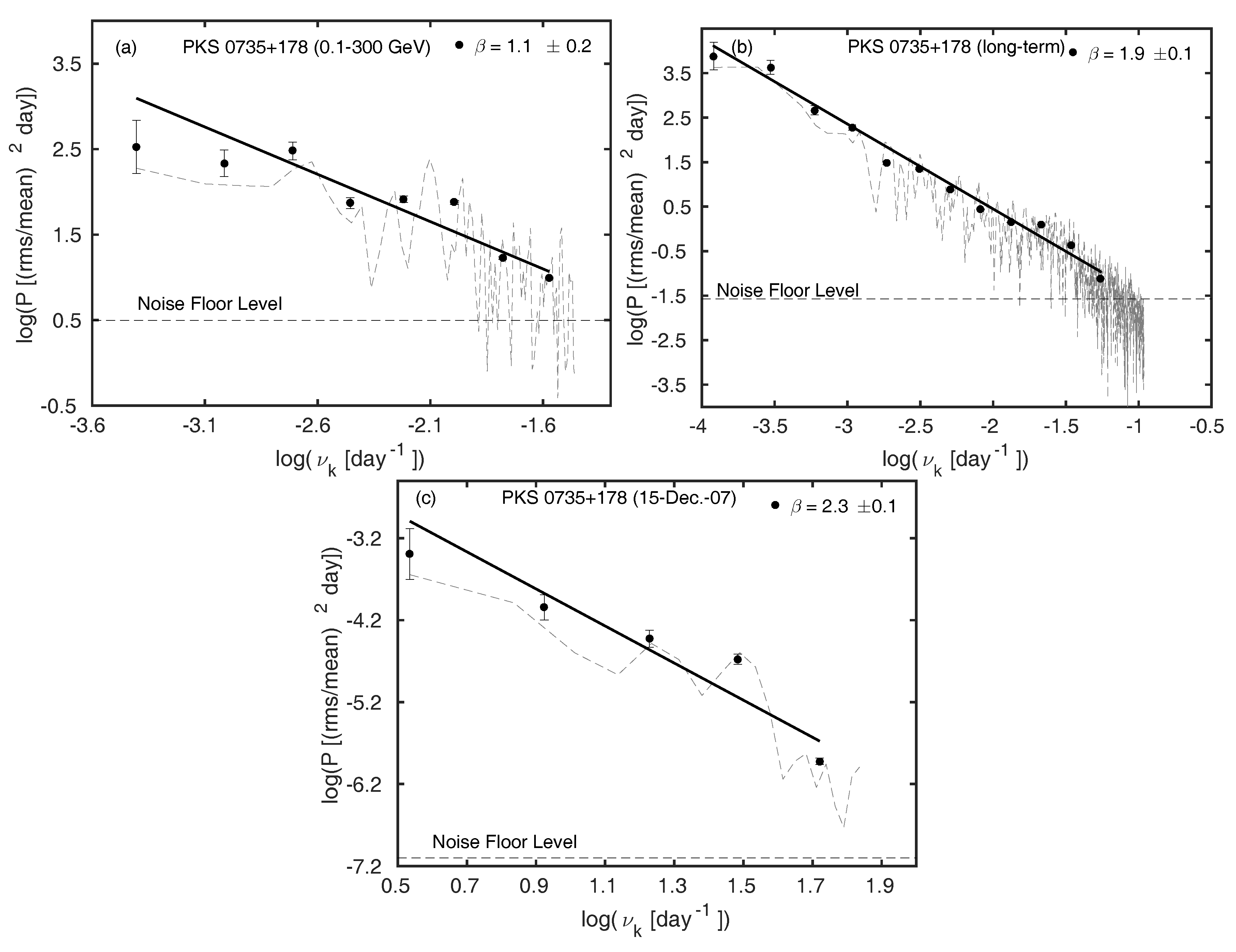
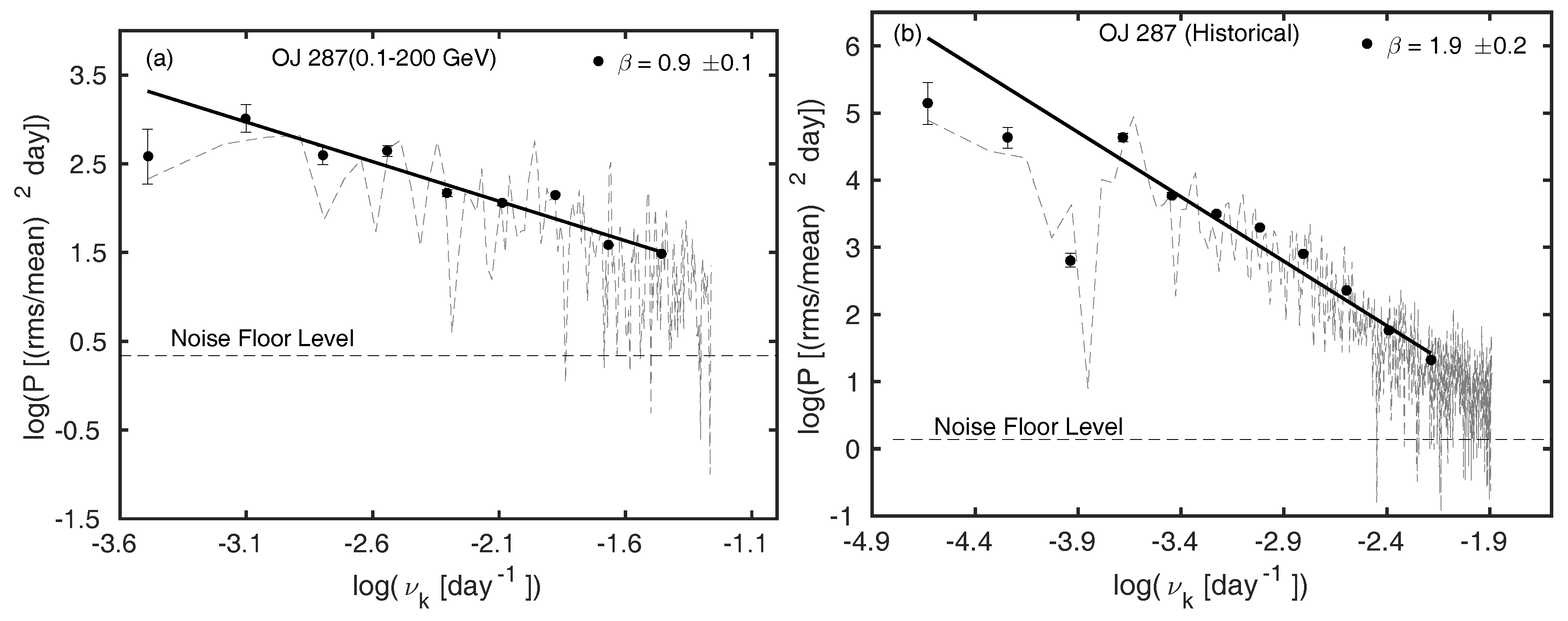
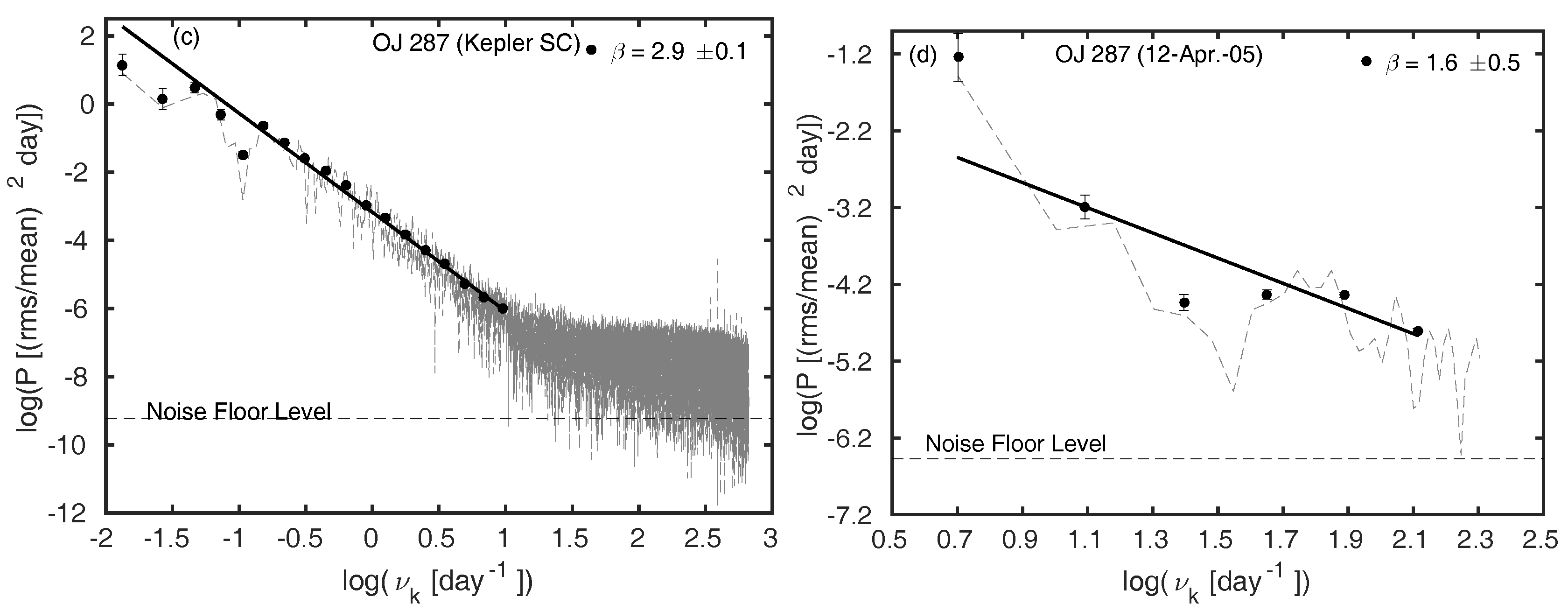
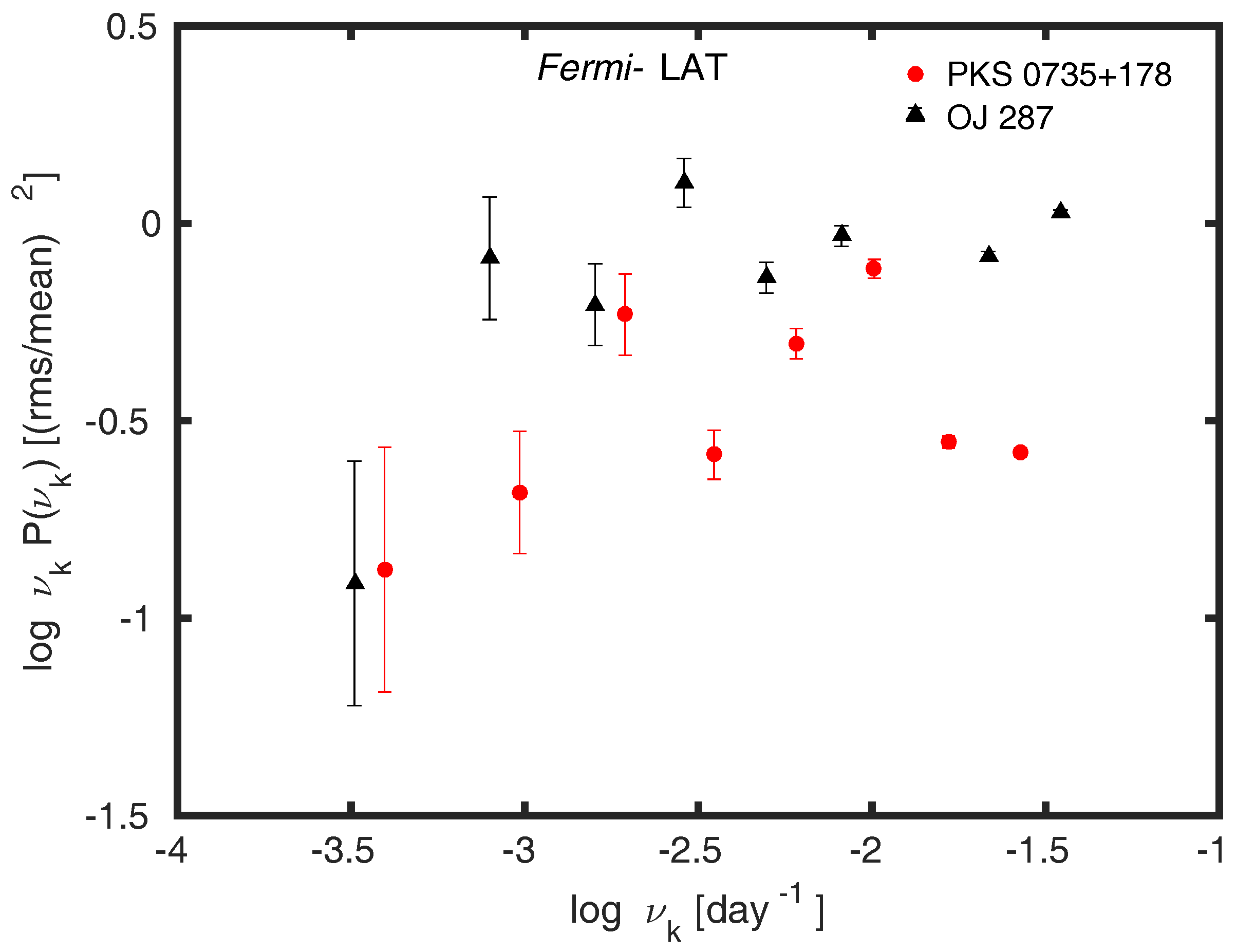
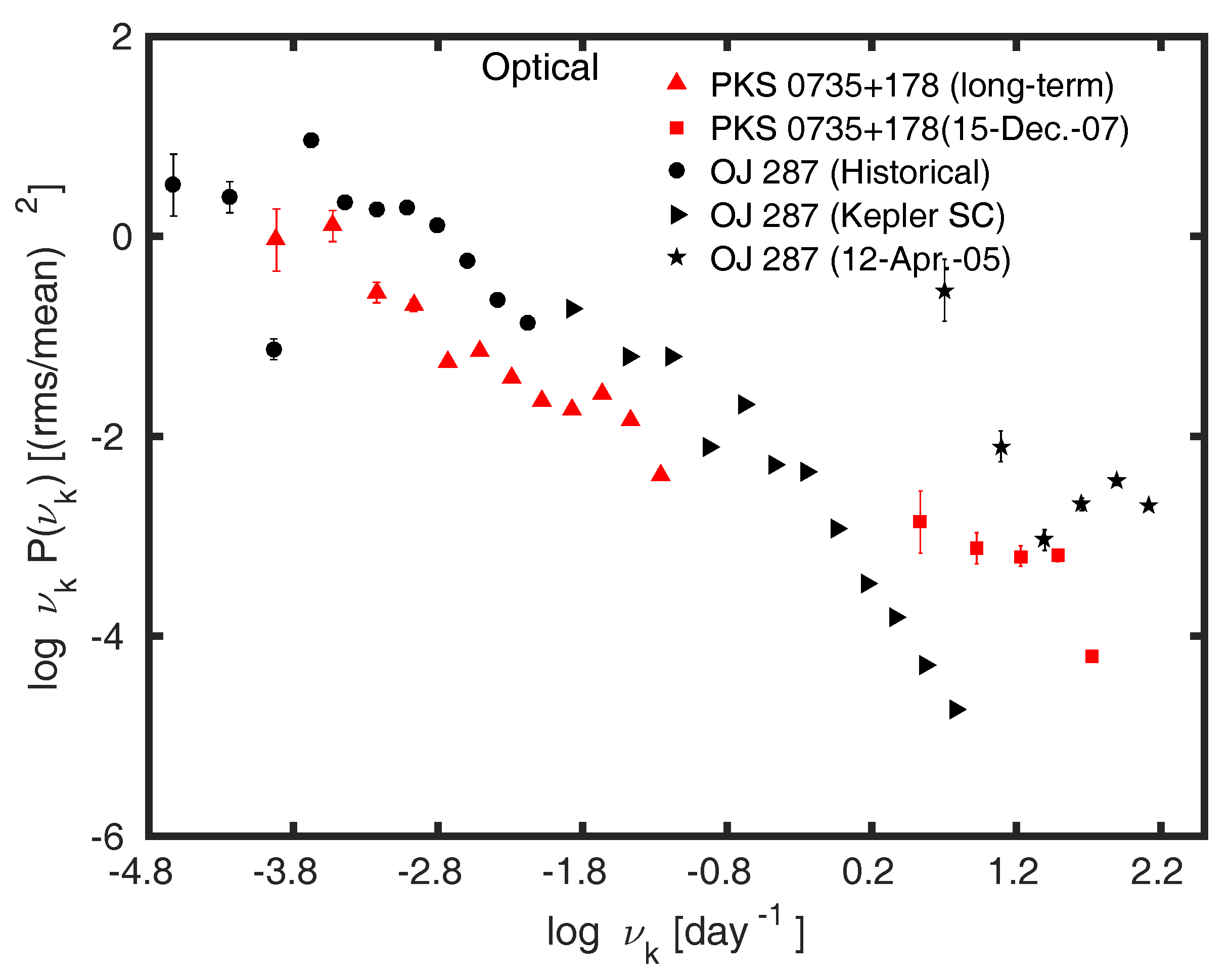
© 2018 by the author. Licensee MDPI, Basel, Switzerland. This article is an open access article distributed under the terms and conditions of the Creative Commons Attribution (CC BY) license (http://creativecommons.org/licenses/by/4.0/).
Share and Cite
Goyal, A. A Comparative Study of Multiwavelength Blazar Variability on Decades to Minutes Timescales. Galaxies 2018, 6, 34. https://doi.org/10.3390/galaxies6010034
Goyal A. A Comparative Study of Multiwavelength Blazar Variability on Decades to Minutes Timescales. Galaxies. 2018; 6(1):34. https://doi.org/10.3390/galaxies6010034
Chicago/Turabian StyleGoyal, Arti. 2018. "A Comparative Study of Multiwavelength Blazar Variability on Decades to Minutes Timescales" Galaxies 6, no. 1: 34. https://doi.org/10.3390/galaxies6010034



